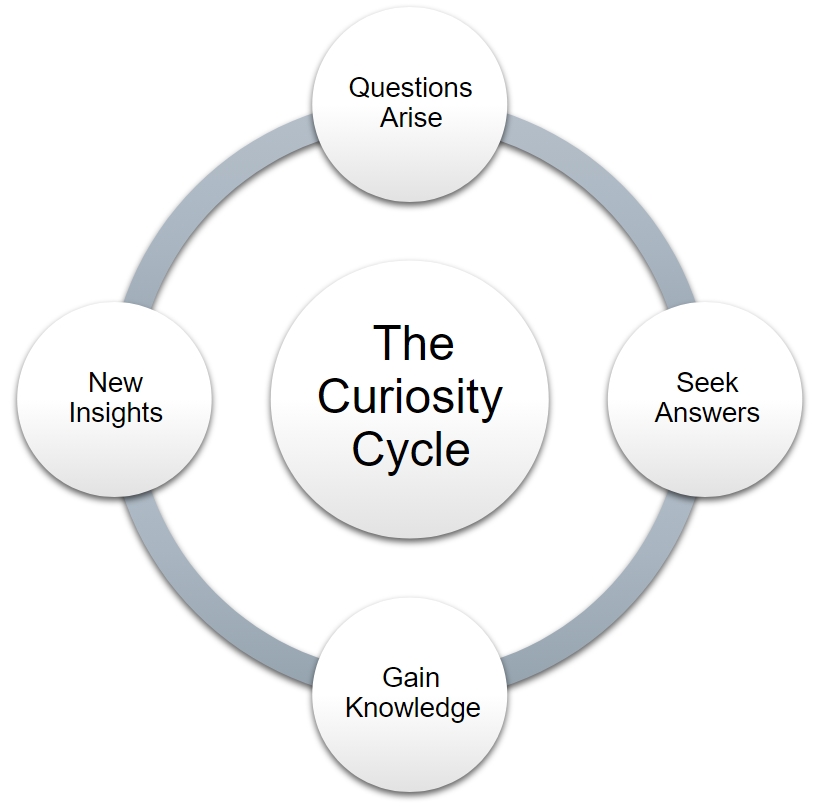Picture this: A young patent clerk in Bern, Switzerland, gazes out the window of his office, lost in thought. He’s pondering a question that’s been nagging at him for years: “What would it be like to ride alongside a beam of light?” This seemingly simple question, born of pure curiosity, would lead Albert Einstein to develop his theory of special relativity and revolutionize our understanding of the universe. Einstein’s story exemplifies the profound connection between curiosity and learning, demonstrating how a single question can spark a journey of discovery that transforms not only individual knowledge but entire fields of study..
Einstein’s story is just one of countless examples that illustrate the transformative power of curiosity. But what exactly is curiosity, and how can we harness it to supercharge our own learning and growth?
In this post, we’ll dive deep into the world of epistemic curiosity – the driving force behind our desire to learn and understand. Whether you’re a student, a lifelong learner, or a professional looking to stay ahead in your field, cultivating this type of curiosity can be your secret weapon for accelerated learning and innovation.
Unlocking Your Brain’s Potential Through Curiosity
The Power of Epistemic Curiosity
Let’s start by unpacking what we mean by “epistemic curiosity.” Unlike its cousin, perceptual curiosity (which is more about novelty-seeking), epistemic curiosity is all about the hunger for knowledge and understanding. It’s that itch you feel when you encounter a gap in your knowledge, and the satisfaction you experience when you fill it.
Dr. Jordan Litman, a leading researcher in the field of curiosity, describes epistemic curiosity as “the desire to obtain new knowledge expected to stimulate intellectual interest.” In other words, it’s not just about collecting random facts; it’s about seeking out information that will expand your understanding and challenge your thinking.
Real-world application of epistemic curiosity can be seen across various fields. In business, companies like Google and 3M have long recognized its value, allocating time for employees to pursue their own curiosity-driven projects. This approach has led to innovations like Gmail and Post-it Notes.
Consider the story of Spencer Silver, a 3M scientist who was curious about developing a super-strong adhesive. Instead, he accidentally created a weak, pressure-sensitive adhesive that could be peeled away easily. Rather than discarding this “failure,” Silver’s curiosity led him to wonder about potential applications for this unusual adhesive. Years later, this curiosity paid off when a colleague used the adhesive to create the first Post-it Note, revolutionizing office communication.

“Curiosity is the compass that points us toward new horizons of knowledge.”
The Neuroscience of Curiosity
Now, let’s dive into what happens in our brains when we’re curious. Neuroscientists have discovered that curiosity primes our brains for learning. When we encounter something that piques our curiosity, there’s increased activity in the hippocampus, a region of the brain associated with memory formation.
Dr. Matthias Gruber and his colleagues at the University of California, Davis, conducted a fascinating study on this topic. They found that when people were curious about the answer to a question, they were better at learning that information. But here’s the kicker: they were also better at learning unrelated information that was presented at the same time.
This suggests that curiosity puts the brain in a state that allows it to learn and retain any kind of information better. It’s like giving your brain a temporary superpower for learning.
So, how can we apply this in our daily lives? Try this: Before diving into a new topic or tackling a challenging task, spend a few minutes brainstorming questions about it. What do you want to know? What puzzles you about this subject? By activating your curiosity, you’re preparing your brain to absorb and retain information more effectively.
A practical example of this could be seen in a classroom setting. Imagine a history teacher who, instead of starting a lesson on World War II with a list of dates and events, begins by asking students to ponder questions like, “What would you do if you were a leader during this time?” or “How do you think everyday life changed during the war?” This approach taps into students’ curiosity, making them more receptive to the factual information that follows.
From Questioning to Quantum Leaps in Learning
One of the biggest obstacles to leveraging curiosity is the fear of asking questions. Many of us have experienced the anxiety of raising our hand in class or speaking up in a meeting, worried that our question might be perceived as “stupid” or that we should already know the answer.
This fear often stems from a fixed mindset – the belief that our intelligence and abilities are static. But research by psychologist Carol Dweck has shown that adopting a growth mindset – the belief that we can develop our abilities through effort and learning – can help us overcome this fear.
In the real world, creating an environment that encourages questioning can lead to remarkable results. Take Pixar, for example. The animation studio is known for its “Braintrust” meetings, where team members are encouraged to ask tough questions and offer honest feedback without fear of repercussion. This culture of open questioning has been credited as a key factor in Pixar’s consistent production of hit films.
Imagine a workplace that implemented a similar approach. Let’s say a marketing team institutes a “No Bad Questions” policy in their brainstorming sessions. Initially, team members might be hesitant, but as they see that all questions are welcomed and valued, participation increases. This leads to more diverse ideas, innovative solutions, and ultimately, more successful campaigns.

“In the realm of learning, questions are more valuable than answers.”
Curiosity: The Ultimate Learning Accelerator
Now that we understand the power of curiosity, let’s explore some practical strategies to cultivate it in our daily lives:
- Develop a “Question Journal” Implementation: Set aside 10 minutes each day to write down questions that occur to you. These could be about anything – from wondering how clouds form to questioning the implications of a new technology you’ve heard about. The act of recording these questions heightens your awareness of your curiosity and encourages you to seek answers.
- Practice the “Five Whys” technique Implementation: When confronted with a problem or trying to understand a concept, ask “why” five times in succession. This technique, developed by Sakichi Toyoda, founder of Toyota Industries, helps you dig deeper into a topic and uncover root causes. For example, if you’re trying to understand climate change, you might start with “Why is the Earth getting warmer?” and continue probing deeper with each subsequent “why.”
- Join or create a “Curiosity Circle” Implementation: Form a group with friends or colleagues dedicated to exploring new topics. Meet regularly (in person or virtually) to discuss interesting ideas, share new learnings, and challenge each other with thought-provoking questions. This not only exposes you to diverse perspectives but also creates a supportive environment for curiosity.
- Implement “Question Time” in your routine Implementation: Dedicate a specific time each week for open-ended exploration. During this time, allow yourself to fall down “rabbit holes” of information, following your curiosity wherever it leads. This could involve reading articles, watching educational videos, or experimenting with new ideas.
- Cultivate a growth mindset Implementation: Challenge your own assumptions and embrace mistakes as learning opportunities. When you encounter a setback, ask yourself, “What can I learn from this?” This shift in perspective can transform challenges from obstacles into opportunities for growth and learning.

“Every ‘why’ is a doorway to deeper understanding.”
The Curiosity Cycle: Your Path to Accelerated Learning
As we wrap up, let’s revisit the key points we’ve covered:
- Epistemic curiosity is a powerful driver of learning and innovation.
- Our brains are wired to learn better when we’re curious.
- Overcoming the fear of asking questions can lead to significant breakthroughs.
- Practical strategies like question journaling and the “Five Whys” technique can help us cultivate curiosity.
Remember, curiosity isn’t just a trait you’re born with – it’s a skill you can develop. By consistently applying these strategies, you can create a self-reinforcing cycle of curiosity and learning. Each question leads to new knowledge, which in turn sparks more questions, propelling you forward in a continuous journey of growth and discovery.
So, here’s my challenge to you: This week, choose one of the strategies we’ve discussed and commit to implementing it. Whether it’s starting a question journal or practicing the “Five Whys,” take that first step towards harnessing the power of your curiosity.
And don’t stop there – share your experiences in the comments below. What questions has this post sparked for you? How do you plan to cultivate your curiosity? Your insights might just inspire someone else on their learning journey.
Remember, in a world of rapid change and information overload, your curiosity is your compass. It will guide you to new ideas, deeper understanding, and unprecedented growth. So go ahead, embrace your inner Einstein, and let your questions lead the way to accelerated learning and innovation.
